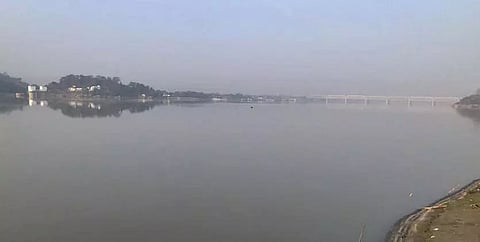
- Home
- Live Blog
- Breaking News
- Top Headlines
- Cities
- NE News
- Sentinel Media
- Sports
- Education
- Jobs

The proposed construction of a four-lane tunnel under the river Brahmaputra between Gohpur on the North bank and Numaligarh on the South Bank has returned to the centre stage with the project details available in the public domain. Comprehensive scientific knowledge about the mighty river still eluding, the question about the likely impact of the engineering marvel on the river morphology due to the disturbance below the riverbed is likely to dominate the discourse. The top of the tunnel is proposed to be 40 meters below the bed of the river. The pre-feasibility report prepared by the NHIDCL (National Highways Infrastructure Development and Corporation Limited) reveals that the 'Artificial Islands' -- proposed on both sides of the river, will act as a bund to prevent the flood water from gushing inside during construction of the tunnel and also during the operational phase. The top of the embankment of the artificial island will be above the high-flood level to take care of the disruption of traffic through the tunnel during floods. Bankline erosion due to the southward movement of the river will pose a challenge of river engineering for protecting the artificial island on the southern side of the river. Erosion caused by the Brahmaputra led to the realignment of the embankment at Palasbari in Kamrup district further to the South more than once.
The benefit of the proposed tunnel when viewed from connectivity point of view is huge. The current travel time of six hours for covering the distance of 220 km between Gohpur and Numaligarh using the Kaliabhomora Bridge will be reduced to half an hour as the distance between the two towns through the twin tunnel will be reduced to 34 km. The project road through the tunnel will connect the National Highway (NH)-52 in Gohpur and the NH-37 in Numaligarh. The NH-37 -- forming a part of the Asian Highway 1, the proposed road and the tunnel will provide connectivity to not only the northern part of the State but also to Arunachal Pradesh to this international highway. The project also has huge strategic importance as it will facilitate quick movement of troops to the forward areas during defence emergency on the India-China border in the Eastern sector. The NHIDCL insists that the tunnel option has paramount strategic benefits for the environment, social and the security point of view during emergency. This is because as the operational connectivity would be maintained which may not be possible for the Bridge option to connect the two towns. The consideration of the strategic importance appears to have led the Central Government granting in-principle approval of the project to be built at an estimated cost of Rs 11,204 crore. Confusion, however, continues to persist if two tunnels are going to be constructed under the river Brahmaputa or the proposed tunnel may be realigned to connect Jamugurihat on the North bank and Silghat on the South Bank which will be closer to the Defence establishments on the southern bank at Misa in Kaliabor. The NHIDCL submitted the application to the 'Expert Appraisal Committee' of the Ministry of Environment, Forest & Climate Change in May for considering the baseline monitoring completed by it for the project. In a tweet on Sunday, Chief Minister Himanta Biswa Sarma mentioned that the State Government has endorsed the Rs 6,550 crore proposed tunnel that will connect Jamugurihat with Silghat. An Additional Director General of BRO had given a presentation on the proposed Brahmaputra tunnel. The project cost of the tunnel endorsed by the State government is less than 60% of the project proposed by the NHIDCL but it is not clear if the cost of the approach roads are included in it or not. Speculation about the exact location of the proposed tunnel will continue until a formal announcement either by the Central government or the State government. On the other hand, the environmental impact of the proposed tunnel on the river will be more important to watch out to find out the sustainability of this project and for mitigation of the possible adverse impact. An ambitious project of dredging the river Brahmaputra initiated by the previous State Government as a solution to the annual floods and erosion had to be shelved after consultation with experts convinced the government that such a solution is not feasible for the stretch within the State without addressing the problem of sedimentation in the entire stretch of the international river flowing through four basin countries. Wide ranging public consultation may lead to answers to some of the questions about the project and trade-off between environmental impact and socio-economic as well as security considerations. A clarification from the government will put such speculations to rest and prevent public discourse from being influenced by narratives built on speculations.